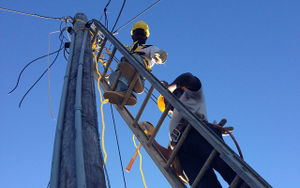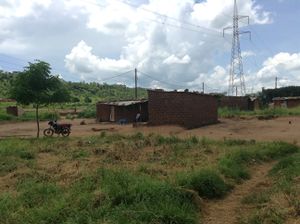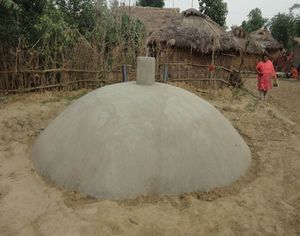Role of Regulation in Energy Access
Overview
Regulation is an activity performed by the state, and most often the task of regulation is granted to an institution (authority, agency, office) that has been given a degree of independence with regard to government, in order to execute this task as effectively as possible.
In a market economy, this kind of institutional arrangement is common of industries in which the direct involvement by a public institution is acknowledged as beneficiary, even necessary. This includes industries such as banking and finance, as well as services of general interest (often designated as “public services”), particularly those services that rely on the use of networks.
Even in economies characterized by an extensive role of the state, including state ownership of companies in select industries, it is a general practice to set up special offices for regulation in key industries. The main reason for this is to be able to assign distinctive tasks to each body operating under the general direction of government. As such, it is the task of the companies to provide goods and services efficiently, while it is the task of the regulatory institution to set rules for protecting the rights and interests of consumers to whom those goods and services are provided.
Regulation is universally applied to energy, particularly to network services such as electricity and, in some countries, to natural gas and district heating as well.
In developing countries, one basic task is to provide universal access to electricity and to some form of clean cooking and heating. In organizing policies to achieve this goal, government has to face a few fundamental choices. According to the choices taken, the regulatory framework takes shape in order to perform its duty as well as possible.
►Go to Top
Role of regulation in access to electricity
1. Electrification by grid extension or off-grid development
One basic choice, in regards to electricity, is between extending the national grid or relying on local isolated systems for the provision of electrification. This choice will depend on the geographic conditions and population density in the areas that need to be electrified, as well as the suitability of various technology options and business models.
While access to energy by the population not served by the national grid is generally not mentioned in the regulator’s mandate, there are good reasons to support the idea that regulators should play a role in the general effort towards achieving universal access to energy, both where the grid exists and where it does not yet exist. The obstacles that need to be addressed in meeting universal access through grid and off-grid are different and need to be clarified.
The role of regulation in areas served by the national distribution grid
The fact that a grid is present does not ensure universal access to the population of the area.
When the cost of connection is an obstacle to access by the poor, some improvement can be achieved by merging the connection charge and the energy tariff into a pay-as-you-go system. This is usually affordable to people with limited resources while preserving the economic stability of the electricity company. Such arrangements can be introduced on a contractual basis by the supplying company within the existing regulatory framework, provided it is not too inflexible, or even promoted by the regulator itself.
Integration of illegal connections into legal and safe systems can be promoted by combining an accurate monitoring of the area, easier bureaucratic procedures, repression of illegality, and affordable service contracts.
Areas not yet served by the grid may be accessed if the grid is extended. Wherever the networks can be extended by private operators or by state-owned operators subject to budget constraints, good regulation can improve the conditions for new investment. In general, uncertainty increases the cost of capital and hinders investment decisions, otherwise profitable at normal levels of risk. Uncertainty may regard the duration of concessions if too short, or possible decisions to modify it; changes in the level of tariffs and in other conditions imposed on business by the institution in charge of regulation; or possible political decisions to change the ownership of industrial assets (nationalisation). Consequently, a stable and sound regulatory framework makes investment more attractive while protecting consumers.
Furthermore, in order to incentivize the distribution operators to invest into grid extensions and new connections, the regulator may define a tariff system, which allows the operators to include the cost of the needed investments into the regulatory asset base and as such cover the costs through the tariffs that are paid by the entire population of customers.
The role of regulation where access to electricity is based on the diffusion of off-grid solutions such as isolated mini-grids or individual home systems.
Access to electricity is possible even outside the reach of large, national or regional networks, as an increasing share of the electricity supply is provided by stand-alone systems or by isolated mini-grids connecting consumers with local generation, often based on renewable sources of energy. Any plan to provide universal access to electricity today must include such systems, since a vast majority of the people currently without access live in rural areas with very low population density. |}
When considering possibleregulation of rural electrification, and in particular off-grid electrification, three fundamental facts should be kept in mind. Each of them raises issues, and the issues are interlinked. Yet, it is useful to mention each one individually.
First, the value of the first kWhs that meet the most basic needs is very high for all consumers. People without access are willing to devote their entire current expenditure on kerosene for lamps and candles, in exchange for a basic electricity service that allows them to switch on a couple of lamps and charge their mobile phone. The price they are willing to pay for these first few, high value kWhs of electricity is much higher than what they are willing to pay for the subsequent kWhs, and this consumer behaviour corresponds perfectly to the profile of an electricity utility function.
It is indeed this willingness to pay a relatively high price for the first kWhs that small local entrepreneurs build their business case upon, when making their offer of an elementary service. There may be no abuse on behalf of the entrepreneur: the offer may reflect the real cost and the poor may be willing to pay the set price.
Second, as the provider of this elementary service holds a monopolistic power, there is a possibility of abuse in this de facto monopolistic position. Therefore, the regulator should protect the consumer against the monopolistic power of the entrepreneur.
Currently, in some countries in South Asia and Sub-Saharan Africa, off-grid systems are the fruit of initiatives by local private entrepreneurs who freely negotiate with the inhabitants of the villages. In absence of any regulation or even monitoring, local, and in many cases, poor consumers end up paying very high prices per kWh for a service that can only satisfy their primary needs and replace unhealthy and technically inferior devices such as kerosene lamps. Since competition for the provision of these basic services is absent or very weak, introducing some kind of price control would be justified.
Third, because the cost of the electricity service is higher where the population is dispersed, a cross-subsidy between urban and rural areas is normal in a grid-connected area to keep the tariff uniform, and a similar subsidy is justified in the case of off-grid systems serving poor people.
Once these three facts are made clear, it becomes clear why some level of regulation is favourable in order to protect the vulnerable dispersed customer, whose needs are best met by some form of off-grid system.
2. The role of government and what markets can do
A second basic choice for the Government is to decide on the ownership of the electrification. Should electrification be done using state-owned entities exclusively, or rather using a combination of existing local utilities (whether government – or privately owned), multinational companies, local or foreign-based non-profits, and small local firms. This is a matter of preferential orientation and favourable conditions can be established by Government intervention to favour the chosen orientation.
The role of regulation, as described above, is essential in both cases.
The IEA predicts that two thirds of new access in sub-Saharan Africa will be best served by off-grid extension. These predictions rely heavily on private sector engagement in the provision of electricity to customers living in dispersed rural areas, including the poor and the most vulnerable. If these predictions are to be met, it is clearly the role of public institutions to establish the needed conditions for private sector involvement in electrification.
It is unlikely that more than one provider will operate in one given area, especially in low-density rural areas. Where competition for the provision of these basic services is absent or very weak, using regulation to set limits to market power would be justified. Monopolistic suppliers may justify high prices with the need of recovering the capital invested under conditions of uncertainty regarding future revenues. Adequate regulation should therefore be designed to protect consumers, possibly through setting an upper limit to tariffs, while protecting investors by reducing uncertainty on future market conditions.
Furthermore, while the cost of electricity service is higher where the population is dispersed, some form of financial support (subsidy) may be needed to cover the difference between the efficient costs of supply and what consumers can afford to pay, which could be estimated as equal to the tariff available to grid-connected consumers. In the case of very poor consumers, the reference level can be identified in the “social” tariff, if such a tariff has been introduced to the benefit of poor consumers in the areas connected to the national grid, as is the case in some countries.
One last item that is worth highlighting is the role of the regulator in setting certain technical standards. An important technical challenge of off-grid electrification is assuring that local systems are compatible with one another and with the existing grid, since inter-connection may be necessary at a later stage. Planning for future interconnection prevents investments from becoming obsolete and stranded, creates a common market for spare parts and can help prevent a locally dominant operator from thwarting competition when it arises.
Role of regulation in access to clean cooking
In addressing access to clean cooking, energy regulation is less important than in the case of electricity. Here we are not dealing with a public service provided by a network but rather witha product (or rather two products, the stove and the fuel), which in principle can be supplied within a free market.
Health regulation has a role here, given the detrimental health effects that cooking on an open fire have: the IEA estimates that 2.5 million people die prematurely each year from illness attributable to the household air pollution caused by the inefficient use of solid fuels for cooking. Our focus in this article is however on what energy policy and energy regulation can do to help.
Energy access programs include:
- (a) distribution of “improved” stoves that allow continued usage of traditional biomass but at higher levels of efficiency, hence reduced consumption of biomass, and drastically lower levels of poisonous smoke.
- (b) substitution of biomass with gas tanks (liquefied natural or petroleum gas, LNG or LPG): this may seem contradictory since gas is less sustainable than biomass, yet gas is the main “transition” fuel that is largely available at a low cost and allows immediate benefits in terms of emissions, impact on local vegetation and gender issues. The 2017 IEA Energy Access Outlook states that “LPG is a common path to access clean cooking options” and presents gas as covering 65% of fuel needs for cooking in developing countries in its hypothetical “energy for all” scenario for 2030.
- (c) diffusion of knowledge and awareness, as well as efforts to change cultural attitudes in certain areas, as conditions for programs for making the switch are accepted.
From an energy regulatory perspective there are two main areas that could be addressed. On the one hand, some level of technical regulation could help address the effectiveness of new stoves, which supports the introduction of quality standards for cook stoves and certification as an integral part of the design, testing (possibly field tests) and implementation of clean cooking solutions.
Next, in order to promote the cleaner types of fuels it is important to remove all tax cuts and subsidies on traditional “dirty” fuels such as coal and kerosene, and where possible move such subsidies to the benefit of the cleaner fuels.
Further Information
- Energy Access Portal
- Energy Planning for Rural Areas
- Typical Regulations for the Installation and Operation of Small Hydro Power Plants
- Policies and Regulations for the Energy-Agriculture Nexus
References
- EnergyAccessOutlook.pdf|World Energy Outlook 2017 Special Report, Energy Access Outlook, IEA, 2017
- Regulation of the Power Sector, Pérez-Arriaga, Ignacio J. (Ed.), Springer, 2013
- Energy Poor, Pippo Ranci, Matteo Leonardi, Laura Susani, Il Mulino, 2017
|
This article is part of the Energy Access Portal which is a joint collaboration between energypedia UG and the “World Access to Modern Energy (WAME)". WAME is managed by the Museo Nazionale della Scienza e Tecnologia Leonardo da Vinci (MuST), the Fondazione AEM and the Florence School of Regulation (FSR) and it is supported by Fondazione CARIPLO. |
Written by: Pia Lovengreen Alessi, Florence School of Regulation and World Access to Modern Energy
























